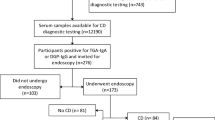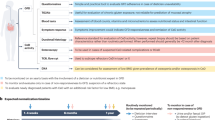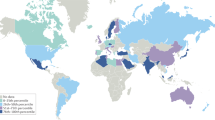Abstract
Celiac disease (CD) affects at least 1% of the Western population but remains largely unrecognized. In our laboratory, we utilize a novel algorithm to diagnose pediatric CD that offers both high sensitivity and high specificity for diagnosis in an outpatient setting. The aim of the present study was to challenge this algorithm and to test its performance in children and adults suspected of having CD. Using a three-assay algorithm, screening with the most sensitive tissue transglutaminase (tTG) complexed with deamidated gliadin peptide neoepitope immunoglobulin A (IgA)+IgG assay and confirming with the two specific tTG IgA and tTG IgA+IgG assays, we examined the serological results from 112 children aged 0–17 years old and 60 adults in comparison to their respective biopsy results. The algorithm performance was calculated by statistical analysis. The use of the new algorithm enabled us to diagnose CD with 98% sensitivity, 93% specificity and 95% accuracy in the pediatric group and 94% sensitivity, 92% specificity and 93% accuracy in the total population studied. The false-negative cases in the adult group were attributed to previous adherence to a gluten-free diet, and the single false-negative result in a young child became a true positive after 6 months. We have also monitored three celiac patients before and after diagnosis and found that the algorithm may be suitable for disease monitoring. The newly proposed three-assay algorithm for celiac detection is very reliable in both children and adults. Due to the high performance of this assay, the further need for confirmatory intestinal biopsies will be reassessed.
This is a preview of subscription content, access via your institution
Access options
Subscribe to this journal
Receive 12 digital issues and online access to articles
$119.00 per year
only $9.92 per issue
Buy this article
- Purchase on Springer Link
- Instant access to full article PDF
Prices may be subject to local taxes which are calculated during checkout
Similar content being viewed by others
References
Gasbarrini G, Malandrino N, Giorgio V, Fundarò C, Cammarota G, Merra G et al. Celiac disease: what's new about it? Dig Dis 2008; 26: 121–127.
Green PH, Cellier C . Celiac disease. N Engl J Med 2007; 357: 1731–1743.
Armstrong MJ, Robins GG, Howdle PD . Recent advances in coeliac disease. Curr Opin Gastroenterol 2009; 25: 100–109.
Hadjivassiliou M, Sanders DS, Grünewald RA, Woodroofe N, Boscolo S, Aeschlimann D . Gluten sensitivity: from gut to brain. Lancet Neurol 2010; 9: 318–330.
Roma E, Panayiotou J, Karantana H, Constantinidou C, Siakavellas SI, Krini M et al. Changing pattern in the clinical presentation of pediatric celiac disease: a 30-year study. Digestion 2009; 80: 185–191.
Fasano A, Araya M, Bhatnagar S, Cameron D, Catassi C, Dirks M et al. Federation of International Societies of Pediatric Gastroenterology, Hepatology, and Nutrition consensus report on celiac disease. J Pediatr Gastroenterol Nutr 2008; 47: 214–219.
Lurz E, Scheidegger U, Spalinger J, Schöni M, Schibli S . Clinical presentation of celiac disease and the diagnostic accuracy of serologic markers in children. Eur J Pediatr 2009; 168: 839–845.
van der Windt DA, Jellema P, Mulder CJ, Kneepkens CM, van der Horst HE . Diagnostic testing for celiac disease among patients with abdominal symptoms: a systematic review. JAMA 2010; 303: 1738–1746.
Shamir R, Eliakim R, Lahat N, Sobel E, Lerner A . ELISA of anti-endomysial antibodies in the diagnosis of celiac disease: comparison with immunofluorescence assay of anti-endomysial antibodies and tissue transglutaminase antibodies. Isr Med Assoc J 2002; 4: 594–596.
Bürgin-Wolff A, Dahlbom I, Hadziselimovic F, Petersson CJ . Antibodies against human tissue transglutaminase and endomysium in diagnosing and monitoring coeliac disease. Scand J Gastroenterol 2002; 37: 685–691.
Jaskowski TD, Donaldson MR, Hull CM, Wilson AR, Hill HR, Zone JJ et al. Novel screening assay performance in pediatric celiac disease and adult dermatitis herpetiformis. J Pediatr Gastroenterol Nutr 2010; 51: 19–23.
Matthias T, Pfeiffer S, Selmi C, Gershwin EM . Diagnostic challenges in celiac disease and the role of the tissue transglutaminase-neo-epitope. Clin Rev Allergy Immunol 2010; 38: 298–301.
Reeves GE, Squance ML, Duggan AE, Murugasu RR, Wilson RJ, Wong RC et al. Diagnostic accuracy of coeliac serological tests: a prospective study. Eur J Gastroenterol Hepatol 2006; 18: 493–501.
Plenge RM . Shared genetic risk factors for type 1 diabetes and celiac disease. N Engl J Med 2008; 359: 2837–2838.
Shaoul R, Lerner A . Associated autoantibodies in celiac disease. Autoimmun Rev 2007; 6: 559–565.
Marai I, Shoenfeld Y, Bizzaro N, Villalta D, Doria A, Tonutti E et al. IgA and IgG tissue transglutaminase antibodies in systemic lupus erythematosus. Lupus 2004; 13: 241–244.
Cataldo F, Marino V, Ventura A, Bottaro G, Corazza GR . Prevalence and clinical features of selective immunoglobulin A deficiency in celiac disease: an Italian multicentre study. Gut 1998; 42: 362–365.
Weir DC, Glickman JN, Roiff T, Valim C, Leichtner AM . Variability of histopathological changes in childhood celiac disease. Am J Gastroenterol 2010; 105: 207–212.
Rashid M, MacDonald A . Importance of duodenal bulb biopsies in children for diagnosis of celiac disease in clinical practice. BMC Gastroenterol 2009; 9: 78.
Walker MM, Murray JA, Ronkainen J, Aro P, Storskrubb T, D'Amato M et al. Detection of celiac disease and lymphocytic enteropathy by parallel serology and histopathology in a population-based study. Gastroenterology 2010; 139: 112–119.
Elli L, Bonura A, Bardella MT . Avoiding duodenal endoscopic biopsies in celiac disease: are we going forward or looking to the past. Dig Liver Dis 2009; 42: 154–155.
Sugai E, Moreno ML, Hwang HJ, Cabanne A, Crivelli A, Nachman F et al. Celiac disease serology in patients with different pretest probabilities: is biopsy avoidable? World J Gastroenterol 2010; 16: 3144–3152.
Lerner A . New therapeutic strategies for celiac disease. Autoimmun Rev 2010; 9: 144–147.
Author information
Authors and Affiliations
Corresponding author
Rights and permissions
About this article
Cite this article
Rozenberg, O., Lerner, A., Pacht, A. et al. A new algorithm for the diagnosis of celiac disease. Cell Mol Immunol 8, 146–149 (2011). https://doi.org/10.1038/cmi.2010.63
Received:
Accepted:
Published:
Issue Date:
DOI: https://doi.org/10.1038/cmi.2010.63
Keywords
This article is cited by
-
Prevalence of Adult Celiac Disease in India: Regional Variations and Associations
American Journal of Gastroenterology (2016)
-
The thrombophilic network of autoantibodies in celiac disease
BMC Medicine (2013)
-
The Clinical Significance of 25OH-Vitamin D Status in Celiac Disease
Clinical Reviews in Allergy & Immunology (2012)



